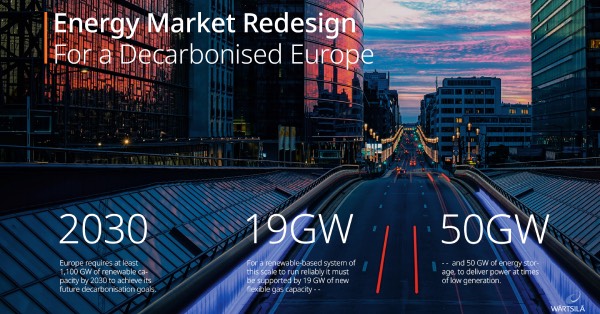The European Commission needs to reform its electricity market design to place a value on flexible balancing power capacity for the EU to achieve its net zero targets and improve energy security, according to a new study from the technology group Wärtsilä.
With the European Commission having engaged in a public consultation for the electricity market design, Wärtsilä has today published Energy Market Redesign: For a Decarbonised Europe. The new study outlines the critical measures which must be introduced to attract investments into flexible balancing power capacity and deliver an affordable and reliable transition to net zero power systems.
Europe will require at least 1,100 GW of renewable capacity by 2030 to continue its decarbonisation journey and ensure energy security. However, for a renewable-based system of this scale to run reliably, it must be supported by 19 GW of new flexible gas capacity and 50 GW of energy storage to deliver power at times of low generation, according to Wärtsilä’s modelling. To enable 100% renewable energy systems, the grid balancing gas engines can be converted to run on sustainable fuels such as hydrogen, when these become readily available.
Håkan Agnevall, President & CEO of Wärtsilä, said: “We stand at the precipice of a transformational shift in European electricity systems, as wind and solar become the dominant power source to achieve net zero. However, the transition cannot be delivered by renewables alone. For the EU to continue to benefit from the competitive cost of renewable energy, we urgently need market reform to ensure security of supply and to give clear market signals to investors to encourage much greater investment in flexible balancing power technologies.”
The inherent variability of renewables means the capacity supplied by a system powered by 1,100 GW of wind and solar could vary by as much as 500 GW over the course of a year, as shown by Wärtsilä’s internal analysis based on PLEXOS modelling. Flexible balancing power capacity is urgently needed to plug the supply gap during these periods of imbalance.
Wärtsilä conducted a model of EU power systems which demonstrates that balancing technologies like reciprocating engines and energy storage will play a crucial role in the EU power system, accounting for 19% share of electricity generation by 2030. The study found that these technologies will need to operate for a few hours each day to ensure grid stability.
In essence, the design of the EU’s current incentives for investment in flexible balancing power capacity risk undermining investment, causing a major bottleneck in the energy transition. Wärtsilä’s modelling shows that the investment case for flexible balancing power capacity could become even more challenging in the future without the right market pricing mechanisms for balancing power.
The study includes a number of key recommendations for market reform, including calls for the European Commission to:
- Define a technology agnostic regulatory framework — creating a new capability market to attract investments in flexible balancing power capacity to support renewables
- Improve price transparency to stimulate growth for flexible balancing power capacity services to support renewables
- Enable strong, granular price signals









































